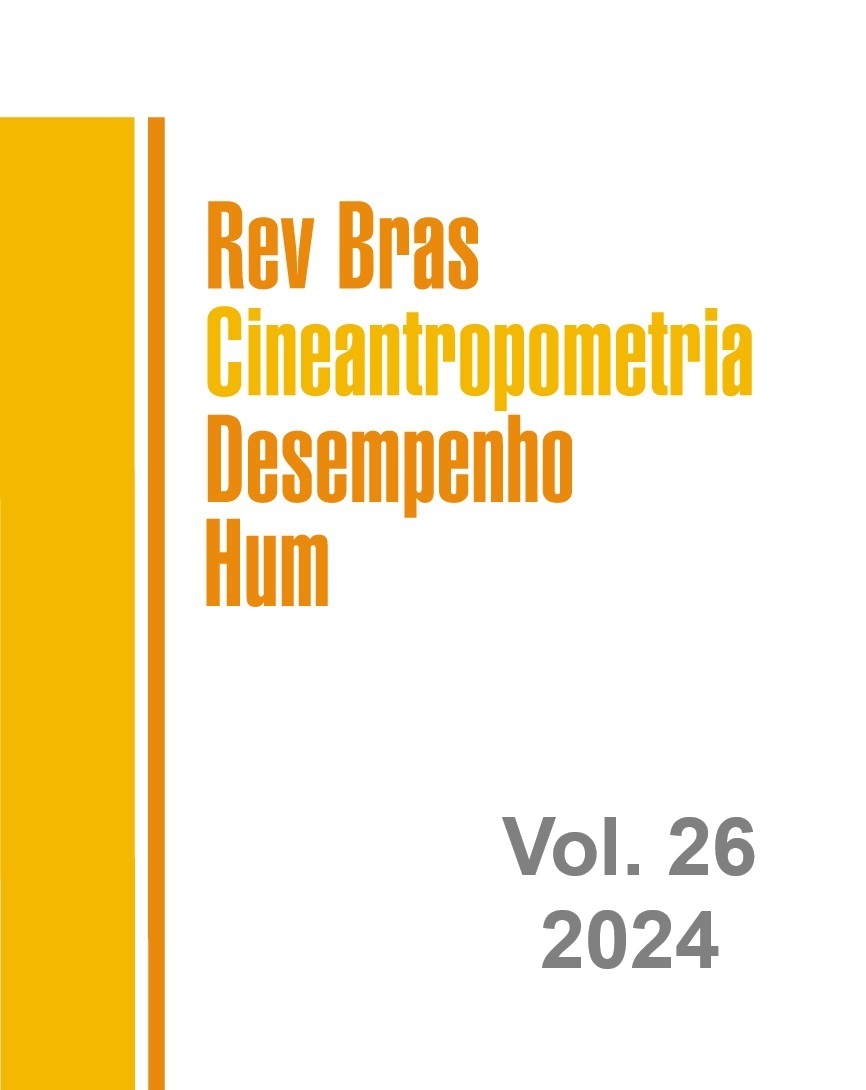Efeito de 12 semanas de treinamento de força sobre o equilíbrio estático de idosos
DOI:
https://doi.org/10.1590/1980-0037.2024v26e86319Palavras-chave:
envelhecimento, equilíbrio postural, treinamentoResumo
O envelhecimento tem impacto direto no equilíbrio devido a alterações da resposta sensorial e motora, sarcopenia e redução da força muscular e da amplitude de movimento que ocorre nos idosos. Nesse contexto, programas de treinamento de força (TF) são vistos como valiosa estratégia para minimizar o efeito deletério do envelhecimento na produção de força e no equilíbrio dessa população. O objetivo do estudo foi avaliar o efeito de 12 semanas de TF com intensidade progressiva sobre as variáveis de equilíbrio estático em idosos. Participaram do estudo 23 idosos com idade média de 65±8,61 anos, de ambos os sexos, que realizaram um programa de TF de doze semanas, com frequência de três vezes por semana e com intensidade progressiva (60 – 85% de 1-RM). O equilíbrio foi avaliado antes e após o período de intervenção, por meio de avaliação estabilométrica em plataforma de força. Após a intervenção houve redução na amplitude anteroposterior (p=0,01), na velocidade anteroposterior (p=0,01) e na área total deslocada (p= 0,04). Conclui-se que o treinamento de força pode ser utilizado como ferramenta chave para minimizar o efeito deletério do envelhecimento na manutenção do equilíbrio estático.
Referências
Papalia JF, Papalia R, Balzani LA, Torre G, Zampogna B, Vasta S, et al. The Effects of Physical Exercise on Balance and Prevention of Falls in Older People: A Systematic Review and Meta-Analysis. J Clin Med. 2020;9(8):2595.
Motalebi SA, Cheong LS, Iranagh JA, Mohammadi F. Effect of low-cost resistance training on lower-limb strength and balance in institutionalized seniors. Exp Aging Res. 2018;44(1):48-61.
Drozdova-Statkeviciene M, Cesnaitiene VJ, Levin O, Pauwels L, Pukenas K, Helsen WF, et al. The beneficial effects of acute strength training on sway activity and sway regularity in healthy older men: Evidence from a posturography study. Neurosci Lett. 2021;749, 135718.
Nascimento LC, Patrizzi LJ, Oliveira CC. Efeito de quatro semanas de treinamento proprioceptivo no equilíbrio postural de idosos. Fisioter. mov. 2012;25(2):325-31.
Figueiredo KM, Lima KC, Guerra RO. Instrumentos de avaliação do equilíbrio corporal em idosos. Rev Bras Cineantropom Desempenho Hum. 2007;9(4):408-13.
Oliveira MD, Linhares LC, Júnior JB, Oliveira LK, Oliveira MC, Coelho DB. Influência da preparação inicial em uma sessão de treinamento técnico sobre o equilíbrio estático em ginastas de trampolim. Revista Brasileira de Prescrição e Fisiologia do Exercício, São Paulo. 2020;14(91):394-401.
Chen J, Chien HF, Francato DC, Barbosa AF, Souza CO, Voos MC, et al. Effects of resistance training on postural control in Parkinson’s disease: a randomized controlled trial. Arq Neuropsiquiatr. 2021;79(6):511-520.
Keating CJ, Cabrera-Linares JC, Párraga-Montilla JA, Latorre-Román PA, Castillo RM, García-Pinillos F. Influence of Resistance Training on Gait & Balance Parameters in Older Adults: A Systematic Review. Int. J. Environ. Res. Public Health. 2021;18(4), 1759.
Alfieri FM, Werner A, Roschel AB, Melo FC, da Silva Santos KI. Mobilidade funcional de idosos ativos e sedentários versus adultos sedentários. Brazilian Journal of Biomotricity. 2009;3(1):89-94.
Teixeira CS, Lemos LF, Lopes LFD, Rossi AG, Mota CB. Equilíbrio corporal e exercícios físicos: uma investigação com mulheres idosas praticantes de diferentes modalidades. Acta Fisiatr. 2008;15(3):156-59.
Liu Cj, Latham NK. Progressive resistance strength training for improving physical function in older adults. Cochrane Database Syst Rev. 2009;(3):CD002759.
Blankevoort CG, Van Heuvelen MJ, Boersma F, Luning H, Jong J, Scherder EJ. Review of effects of physical activity on strength, balance, mobility and ADL performance in elderly subjects with dementia. Dement Geriatr Cogn Disord. 2010;30(5):392-402.
Lohman TG, Roche A, Martorell R. Anthropometric standardization reference manual. Human Kinetics Books, 1988.
Lipschitz DA. Screening for nutritional status in the elderly. Primary care. 1994;21(1):55-67.
Mann L, Kleinpaul JF, Teixeira CS, Rossi AG, Lopes LF, Mota CB. Investigação do equilíbrio corporal em idosos. Rev. bras. geriatr. Gerontol. 2008;11(2):155-65.
Silva RB, Mattos H, Xavier LM, Przysiezny W. Análise da influência imediata das peças podais no equilíbrio corporal através da estabilometria. Universidade Estadual Paulista. 2007:1-6.
Brzycki M. Strength testing: predicting a one-rep max from reps-to-fatigue. Journal of Physical Education, Recreation & Dance. 1993;64(1):88-90.
Hauser E, Martins VF, Teixeira AR, Zabaleta AD, Gonçalves AK. Relação entre força muscular e equilíbrio de idosos no programa de equilíbrio. ConScientiae Saúde. 2013;12(4):580-7.
Morais IJ, Rosa MT, Securon RÉ, Rinaldi W. A melhora da força muscular em idosas através de um programa de treinamento de força de intensidade progressiva. Journal of Physical Education. 2004;15(2):7-15.
Junior RJ, Silva SA, Batista SA, Silva EJ. Benefícios da prática de exercícios resistidos na prevenção de quedas em idosos: uma revisão sistemática. 2021; 19(2):85-91.
Bellew JW, Yates JW, Gater DR. The initial effects of low-volume strength training on balance in untrained older men and women. J Strength Cond Res. 2003;17(1):121-8.
Silva F, Duarte P, Ramalho A, Marinho D. Recomendações para o treino de força em idosos: uma breve revisão da literatura. Revista Científica da Universidade do Mindelo. 2018;5(2):43-55.
Mañas A, Gomez-Redondo P, Valenzuela PL, Morales JS, Lucía A, Ara I. Unsupervised home-based resistance training for community-dwelling older adults: A systematic review and meta-analysis of randomized controlled trials. Ageing Res. Rev. 2021; 69, 101368.
Deandrea S, Bravi F, Turati F, Lucenteforte E, La Vecchia C, Negri E. Risk factors for falls in older people in nursing homes and hospitals: A systematic review and meta-analysis. Arch Gerontol Geriatr. 2013;56(3):407-15.
Downloads
Publicado
Edição
Seção
Licença

Direitos Autorais para artigos publicados nesta revista são do autor, com direitos de primeira publicação para a revista. Em virtude da aparecerem nesta revista de acesso público, os artigos são de uso gratuito, com atribuições próprias, em aplicações educacionais e não-comerciais, desde que seja dada a atribuição. Esta obra foi licenciada com uma Licença Creative Commons Atribuição 4.0 Internacional - CC BY


